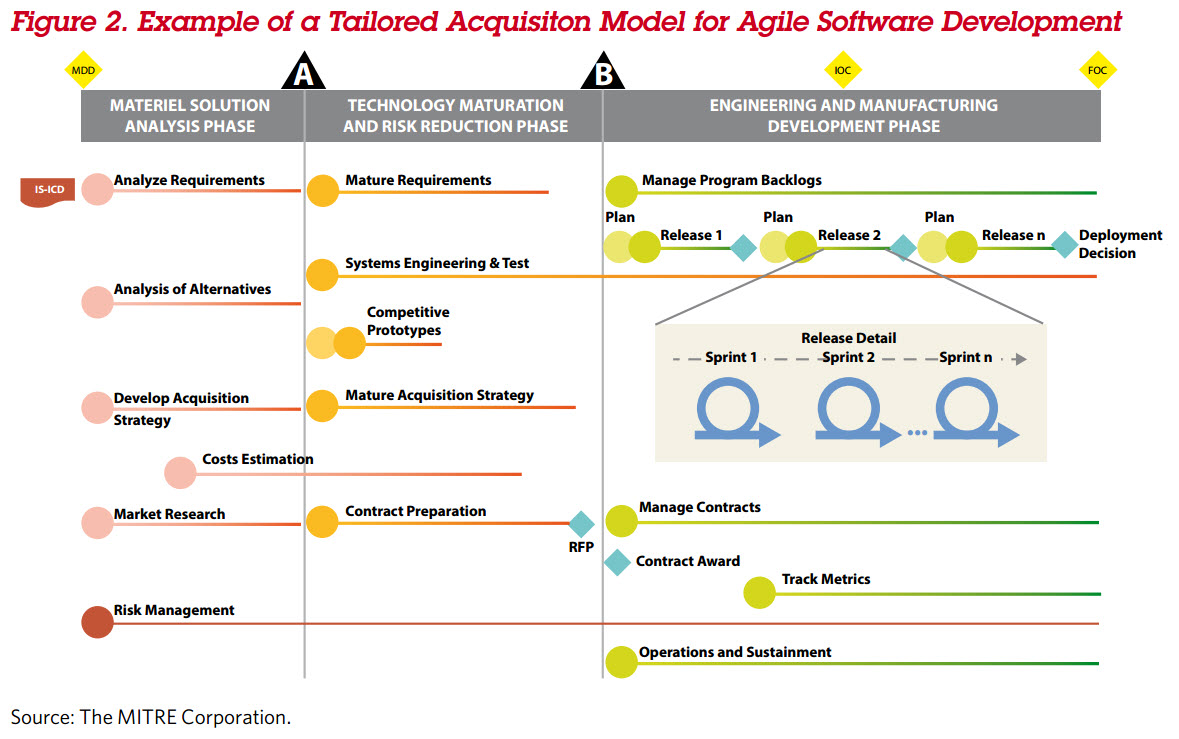Tailor Acquisition Pathways
An acquisition pathway is the execution route a program takes from inception (identification of a materiel solution need) to completion (disposal). The pathway is defined by a series of statutory and regulatory activities, milestones, and decision points. Historically, the generic DoD acquisition program execution pathway was visualized as an all-encompassing model defined in the DoD Directive 5000 series. Acquisition practitioners commonly refer to this extensive model as the “horse blanket” because when printed out full size for readability, the model is large enough to place under a horse’s saddle.
Today, an acquisition executive or portfolio manager can establish tailored acquisition pathways into a program-specific model to enable programs to navigate the complex acquisition environment faster by having pre-filtering and clearly identifying the specific processes, documents, and reviews relevant for that type of acquisition. This is an upfront enterprise/portfolio investment to enable acceleration of current and future programs.

If a Service or Portfolio Acquisition Executive approves these models for their organization, programs no longer have to request tailoring permission and obtain waivers from multiple oversight organizations. Programs can operate with pre-authorization to streamline specific procedures and documents based on the type of product or service being acquired.
Each acquisition program has unique requirements and features; however, several categories or groupings of acquisitions could benefit from having their own tailored acquisition model. DoD could develop a suite of proactively tailored acquisition models to cover a broad range of commonly acquired products and services, such as aircraft, ships, ground vehicles, space systems, missile/munition, IT, communications and networks, business systems, and technical services. Conversely they can be designed around acquisition type or methodology (e.g., agile software development, cloud-based services).
Tailored acquisition models will not replace or eliminate critical thinking. They will offer a better starting position for the acquisition workforce to work from. This enables the workforce to spend less time identifying the processes and documents, less time negotiating the tailoring processes with functional leaders, and more time designing innovative strategies to deliver mission critical capabilities. Best practices and lessons learned can be folded into the models to more broadly replicate effective practices throughout the workforce. This will accelerate the learning curve for the acquisition workforce by providing more direct access to the information that is relevant to each acquisition and saving the workforce considerable time and effort that might otherwise be lost attempting to identify and seek concurrence on the required activities and documentation. Programs can save months in planning and coordinating a tailored approach.
Models ideally would include guidance and recommended templates for each required program document with tailored questions to drive critical thinking for the unique aspects of the program strategy. Acquisition executives could infuse their strategic guidance into the models with better assurance that programs will follow them as they navigate the acquisition life cycle. Each organization can collect best practices and lessons learned from acquisitions of that program type and integrate the organization-unique policies, processes, documents, and approvals into the model.
USD(A&S) Adaptive Acquisition Framework (AAF)
USD(A&S) developed the Adaptive Acquisition Framework to highlight there are multiple acquisition pathways to deliver capabilities to users. The details can be found at https://aaf.dau.edu/aaf/.

Actions You Can Take
- Discuss tailored acquisition models with your acquisition executive, portfolio manager, or director.
- Identify a common set of acquisitions that would benefit from a tailored acquisition model.
- Identify forward thinkers and key leaders from each functional and stakeholder organization to collaboratively develop tailored acquisition models via small, empowered teams.
- At a minimum, be sure to include functional representatives from program management, engineering, contracting, finance, cost, legal, and logistics to ensure holistic discussion across the program’s lifecycle.
- Provide the teams a set of guiding principles (e.g. speed and simplicity are priorities).
- Have the team identify the core processes, reviews, documentation for the type of acquisition and applicable policies and statute.
- Iterate on models that streamline the process and provide tailored guidance to programs.
- Explore hosting the models via an internal or external website to allow for wide dissemination and easy updates.
References
- Proactively Tailored Acquisition Models, Defense AT&L Magazine
- Adaptive Acquisition Framework, USD(A&S)
- Tailored Agile Acquisition Model, AiDA
- Proactively Tailored Models – The Google Maps of Accelerated Acquisition, MITRE
- 9 Tailored IT Acquisition Models, Defense Information Systems Agency (DISA)
